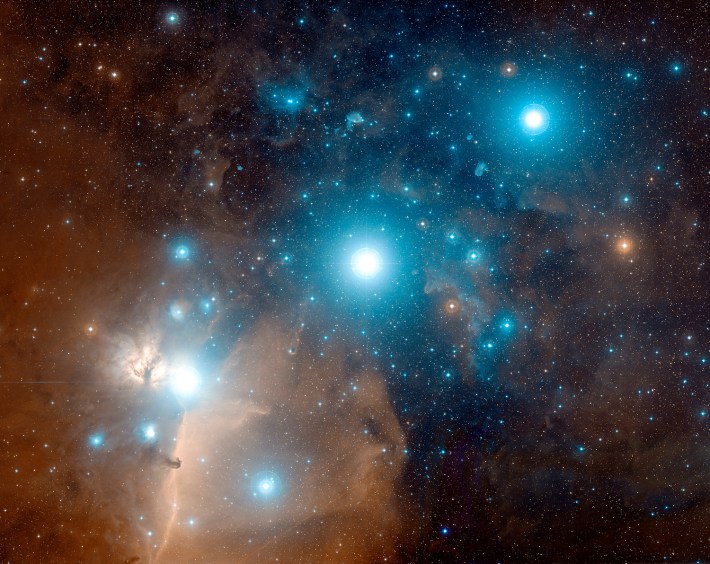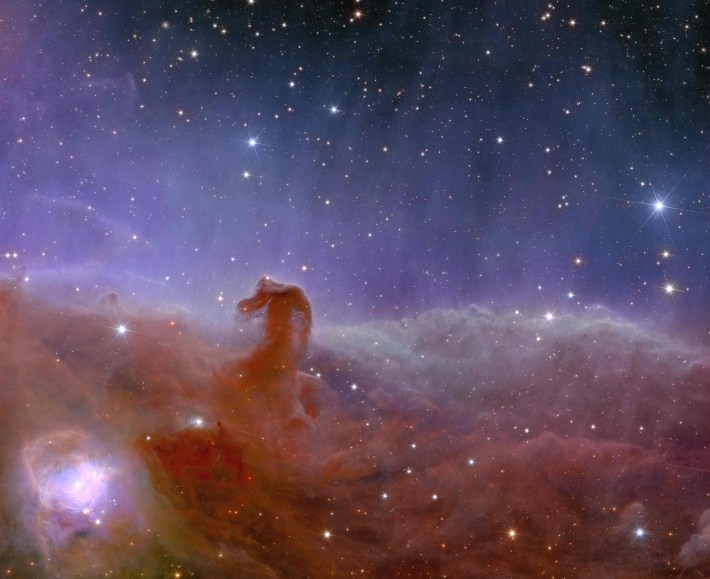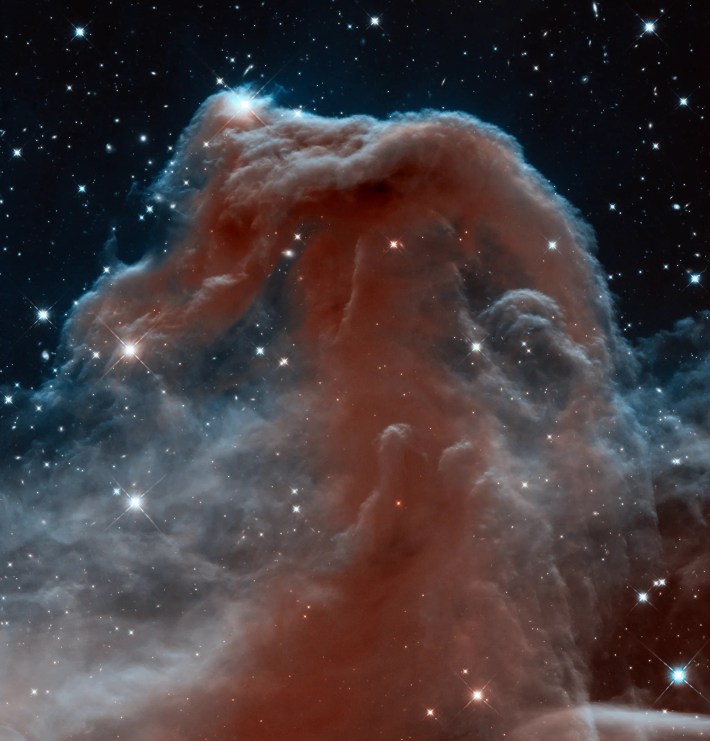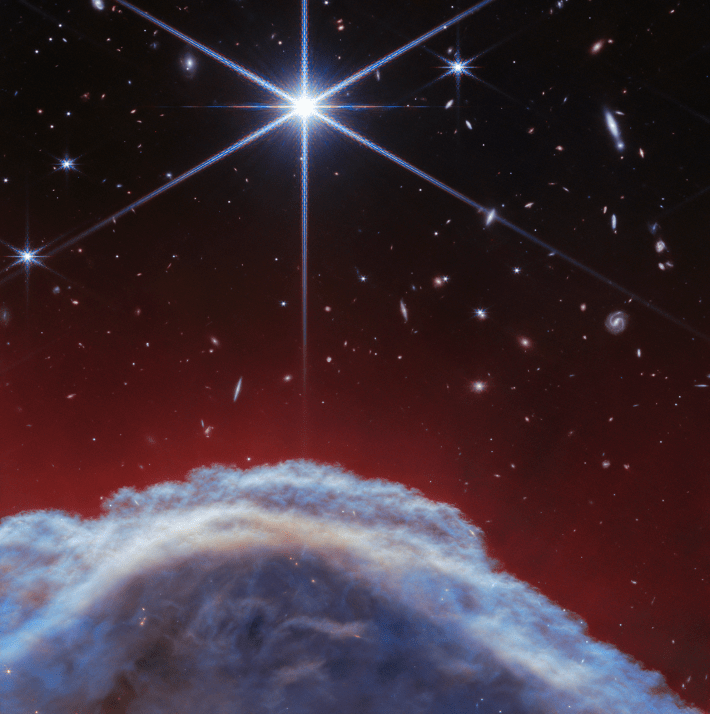Part of the difficulty in conceptualizing the imaging power of the James Webb Space Telescope is that the universe is very large, and frames of reference are unfamiliar. You can look at something like the Whirlpool Galaxy and be told that it's 32 million light years away but that doesn't mean anything to a human brain which never evolved to consider light years. So it's helpful when Webb images capture something we know intimately—even/especially if it's a minuscule slice of that thing, now capable of being seen in its universe-spanning glory.
So, let's take an aesthetic page from Powers of Ten and zoom in on the Horsehead Nebula.
You know the constellation Orion. Humans have known it, and drawn pictures in it, since the dawn of human history. Even in light-polluted urban areas, you can spot the three blue supergiant stars in a row that make up its "belt." It took until 1888 for Williamina Fleming, a Scottish astronomer working at Harvard, to spot a curious, dark region right below the easternmost of the three stars in Orion's Belt. It was one of the earliest identified dark nebulas, a region of interstellar dust and gas so dense that it blocks light. It's part of the larger Orion molecular cloud, a stellar nursery where untold numbers of stars are being born—including the three older stars making up the Belt, which have since drifted outside the cloud.
But let's go back to considering scale. Dubbed Barnard 33, the dark nebula needed many, many more years for telescope technology to improve to the point where it could be resolved. When it was, the nebula displayed a feature so clear that its nickname became obvious.

The above image was captured by the ground-based Samuel Oschin Telescope in the late 1980s. To orient yourself: the three brightest, bluest points are the stars of Orion's Belt. Just below the leftmost one is a bright filament interrupted with a dark column. That column is the Horsehead Nebula. See it?

This image, from ESA's Euclid Space Telescope, is pretty arresting. To ground ourselves on Earth again, the Horsehead Nebula appears to us about eight arc minutes across, or 8/60 of a degree, which itself is 1/360 of the night sky. Very small, and still we were able to make it shockingly clear.
But we could get clearer.

In 2013, NASA published the above image from the Hubble Space Telescope, of the "head" of the horse. We've come a long way.
But a funny thing happens when you look at our big honking universe. Anything with a sense of scale breaks down under enough magnification, because there is something smaller, older, farther away behind it. Lots of somethings. Zoom in far enough and you realize you were only scratching the surface. Which is how we get the Webb image published this week in Astronomy & Astrophysics:

The structure at the bottom is a tiny, tiny part of the dust clouds at the "top" of the Horsehead Nebula. (Check out the scale of this thing!) And beyond it? Well, beyond it is everything. In this image, the six-pointed dots of light are stars in our own galaxy—they appear that way because of Webb's hexagonal mirror. Everything else in the infrared image are galaxies—older, distant galaxies, each with their own hundred-billion-or-so stars, and countless nebulae pumping them out. Zoom in far enough on any patch of sky and this is what you will see; the universe operates on orders of magnitude our eyes cannot comprehend. And just as Webb pried deeper into the cosmos than Hubble could, and as Hubble improved on what came before it, some day something will make Webb seem as primitive as Williamina Fleming making out a dark smudge on a photographic plate.
There is value in close-imaging something like the Horsehead Nebula for what it can teach us about star formation, but this requires astrophysics beyond my comprehension. Instead I'm content to be taken by the clamor and congestion of the background: The more we can see, the more we learn just how infinitesimal is the part of creation that we can know.
![The NASA/ESA/CSA James Webb Space Telescope has captured the sharpest infrared images to date of one of the most distinctive objects in our skies, the Horsehead Nebula. These observations show a part of the iconic nebula in a whole new light, capturing its complexity with unprecedented spatial resolution. Webb’s new images show part of the sky in the constellation Orion (The Hunter), in the western side of the Orion B molecular cloud. Rising from turbulent waves of dust and gas is the Horsehead Nebula, otherwise known as Barnard 33, which resides roughly 1300 light-years away. The nebula formed from a collapsing interstellar cloud of material, and glows because it is illuminated by a nearby hot star. The gas clouds surrounding the Horsehead have already dissipated, but the jutting pillar is made of thick clumps of material that is harder to erode. Astronomers estimate that the Horsehead has about five million years left before it too disintegrates. Webb’s new view focuses on the illuminated edge of the top of the nebula’s distinctive dust and gas structure. The Horsehead Nebula is a well-known photon-dominated region, or PDR. In such a region ultraviolet light from young, massive stars creates a mostly neutral, warm area of gas and dust between the fully ionised gas surrounding the massive stars and the clouds in which they are born. This ultraviolet radiation strongly influences the gas chemistry of these regions and acts as the most important source of heat. These regions occur where interstellar gas is dense enough to remain neutral, but not dense enough to prevent the penetration of far-ultraviolet light from massive stars. The light emitted from such PDRs provides a unique tool to study the physical and chemical processes that drive the evolution of interstellar matter in our galaxy, and throughout the Universe from the early era of vigorous star formation to the present day. Owing to its proximity and its nearly edge-on geometry, the Horsehead Nebula is an ideal target for astronomers to study the physical structures of PDRs and the evolution of the chemical characteristics of the gas and dust within their respective environments, and the transition regions between them. It is considered one of the best objects in the sky to study how radiation interacts with interstellar matter. This image was captured with Webb’s NIRCam (Near-InfraRed Camera) instrument. [Image description: At the bottom of the image a small portion of the Horsehead Nebula is seen close-in, as a curved wall of thick, smoky gas and dust. Above the nebula various distant stars and galaxies can be seen up to the top of the image. One star is very bright and large, with six long diffraction spikes that cross the image. The background fades from a dark red colour above the nebula to black.]](https://lede-admin.defector.com/wp-content/uploads/sites/28/2024/04/STScI-01HV4CG0EACM1MC07E10X19KNX.jpg?w=2880)





